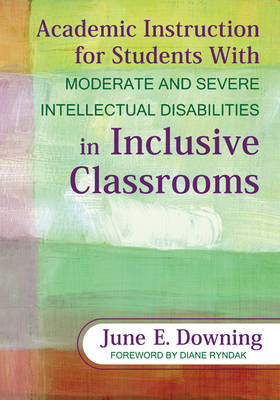
Academic Instruction for Students With Moderate and Severe Intellectual Disabilities in Inclusive Classrooms
Corwin Press Inc (Verlag)
978-1-4129-7142-3 (ISBN)
"A useful resource for all educational teams who plan for students with moderate and severe intellectual disabilities. Downing summarizes current, key research and offers practical applications from her wealth of experience in schools. Readers who are new to planning for students with severe disabilities will find excellent coverage of the basics like systematic instruction, positive behavior support, and collaboration. Professionals with extensive experience will benefit from the new ideas for planning, including specific examples of adapting academic content, considering both family goals and state standards in planning, and using universal design for learning."
—Diane M. Browder, Snyder Distinguished Professor of Special Education
University of North Carolina at Charlotte
Help students with significant disabilities succeed in the general education classroom!
While most resources for inclusive education focus on teaching students with mild to moderate disabilities, teachers of students with more severe disabilities need specific methods to provide the individualized and systematic instruction necessary to support students in inclusive environments. This unique book meets that need with approaches, information, and ideas for teachers of students with moderate to severe disabilities in general education classrooms.
June E. Downing draws from a strong research base to provide practical instructional strategies, plus suggestions based on personal experience. Featuring tables and figures, chapter summaries, photographs, multiple examples, and strategies that address the how-to of instruction, this resource helps general and special education teachers:
Adapt their curriculum to meet both individual student needs and state standards for core curriculum
Work collaboratively with other teachers
Develop assessments that accurately determine student needs
Keep track of student progress through data collection
Essential for today′s inclusive classrooms, this guide covers everything teachers need to know to provide individualized instruction and assessment for their students with significant intellectual disabilities.
June E. Downing is Professor Emerita of Special Education at California State University, Northridge, and prior to that was at the University of Arizona in Tucson, where she did research and prepared teachers to work in the area of moderate, severe, and multiple disabilities. She is a national leader in the field of special education that targets the needs of students with severe disabilities, especially with regard to inclusive education. She has published numerous articles, chapters, monographs, and seven books on students having severe and multiple disabilities. She served for six years on the Executive Board of TASH, an international advocacy organization for individuals with severe disabilities, and was a past president of the California Chapter of this organization—CalTASH as well as AZTASH. She has served as an associate editor of Research and Practices for Persons With Severe Disabilities and currently serves on this board as well as several other professional editorial boards. She is presently serving as an educational consultant, traveling extensively in the United States and abroad to do presentations on various subjects.
Foreword. by Diane Ryndak - Diane Ryndak
Preface
Acknowledgments
About the Author
1. Teaching Students With Moderate to Severe Intellectual Disabilities in General Education Classrooms: Foundational Beliefs
Key Concepts
A Historical Perspective: Where We Came From
The Present Situation and Challenge
What is Inclusive Education?
What is Not Inclusive Education
Who Are We Talking About?
Summary
2. Instructional Strategies and Teaching Arrangements
Key Concepts
Characteristics of Effective Instruction for All Students
Clear Expectations
Analyzing Tasks for Improved Learning
What We Know About Teaching Students with Moderate to Severe Intellectual Disabilities
The Importance of Student Interests
Components of the Teaching Task
Prompting Strategies
Consequences of the Behavior
Using Sequences of Different Prompts to Teach Students: Shaping Behavior
Maintaining and Generalizing Skills
Teaching Arrangements in General Education Classrooms
Summary
3. Determining Student Needs: What to Teach
Key Concepts
Limitations of Standardized Assessment
Family and Child-Based Assessment Procedure
Record Review
Observational Assessments
What’s the Class Doing?
Interpreting Content Standards
Blending Student/Family Goals with State Standards
Identifying Learning Opportunities
Writing IEP Goals and Objectives
Summary
4. Teaching Core Curriculum to Students With Moderate to Severe Intellectual Disabilities
Key Concepts
The Critical Need to Adapt Curriculum to Make it Meaningful
Identifying the BIG Ideas from Core Curriculum
Determining Prompts to Use for a Particular Student and Lesson
Examples of Students Receiving Direct Instruction Across Grades and Instructional Arrangements
Large Group Instruction
Generalization of Skills Taught
Summary
5. It Takes a Village: Teaching as a Collaborative Effort
Key Concepts
The Expectation of Team Collaboration
Team Members Involved in Instruction
Credentialed Teachers
Co-Teaching
Supporting General Education Ownership
Paraprofessionals as Teachers
Related Service Providers
Parent Volunteers
Peers as Teachers
A Few Cautions When Using Peers
The Need for Information and Training
Effective Use of Team Members
The Importance of Consistency
Generalization of Skills Across Team Members
Summary
6. Keeping Track of Student Progress, by Kathryn D. Peckham-Hardin and June E. Downing
Key Concepts
Types of Data Collection Strategies
Linking Data Collection Methods to the IEP Objectives
Collecting Data While Teaching in General Education Classrooms
Examples of Collecting Data During Instructional Times
Test Taking by the Class
Training Paraprofessionals and Others to Take Data
The Need for Alternate Assessment
Summary
7. He’s Getting It! Now What? Taking Learning to the Next Level
Key Concepts
Involving the Student in Planning Next Steps
Writing IEP Objectives to Reflect Next Steps
Using Standards and Performance Indicators to Determine Next Steps
Using Task Analyses to Determine Next Steps
Using Life Needs to Determine Next Steps
Postsecondary Options
Next Steps for Nonacademic Skills
Summary
References
Index
| Erscheint lt. Verlag | 5.5.2010 |
|---|---|
| Verlagsort | Thousand Oaks |
| Sprache | englisch |
| Maße | 215 x 279 mm |
| Gewicht | 550 g |
| Themenwelt | Sozialwissenschaften ► Pädagogik ► Sonder-, Heil- und Förderpädagogik |
| ISBN-10 | 1-4129-7142-X / 141297142X |
| ISBN-13 | 978-1-4129-7142-3 / 9781412971423 |
| Zustand | Neuware |
| Haben Sie eine Frage zum Produkt? |
aus dem Bereich


